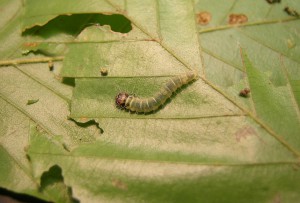Podcast: Play in new window
BOB HIRSHON (host):
Caterpillar housing developments. I’m Bob Hirshon and this is Science Update.

It’s a tough world for tiny caterpillars, who face countless predators. Some hide by spinning thread and fastening overlapping leaves together, to make little houses. Biologist John Lill at George Washington University says the homes give shelter not only to the caterpillars, but to dozens of other organisms that drop in.
JOHN LILL (George Washington University):
They’re really excellent examples of what we call ‘ecosystem engineers’. So they’re animals basically that modify habitats that then influence the diversity and composition of other organisms in their community.
HIRSHON:
Beetles, spiders, and other caterpillars take refuge in the homes, greatly increasing the number of species that can coexist on a single tree. Researchers are discovering that these tiny shelter-builders have an outsized effect on forest ecosystems, from the far north to the tropics. I’m Bob Hirshon, for AAAS, the science society.
